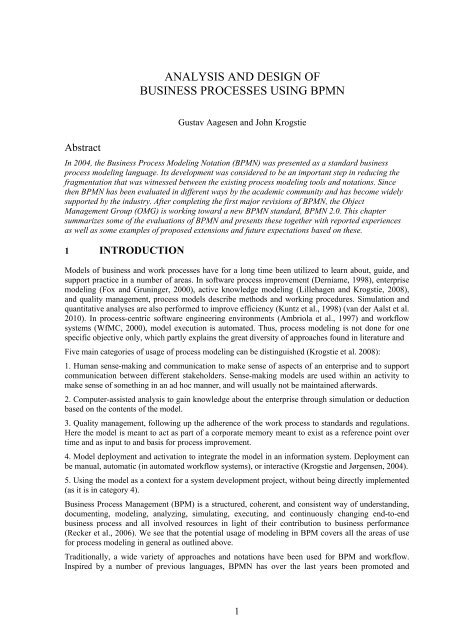Multi-channel provisioning of public services - Department of ...
Multi-channel provisioning of public services - Department of ...
Multi-channel provisioning of public services - Department of ...
Create successful ePaper yourself
Turn your PDF publications into a flip-book with our unique Google optimized e-Paper software.
ANALYSIS AND DESIGN OF<br />
BUSINESS PROCESSES USING BPMN<br />
Abstract<br />
Gustav Aagesen and John Krogstie<br />
In 2004, the Business Process Modeling Notation (BPMN) was presented as a standard business<br />
process modeling language. Its development was considered to be an important step in reducing the<br />
fragmentation that was witnessed between the existing process modeling tools and notations. Since<br />
then BPMN has been evaluated in different ways by the academic community and has become widely<br />
supported by the industry. After completing the first major revisions <strong>of</strong> BPMN, the Object<br />
Management Group (OMG) is working toward a new BPMN standard, BPMN 2.0. This chapter<br />
summarizes some <strong>of</strong> the evaluations <strong>of</strong> BPMN and presents these together with reported experiences<br />
as well as some examples <strong>of</strong> proposed extensions and future expectations based on these.<br />
1 INTRODUCTION<br />
Models <strong>of</strong> business and work processes have for a long time been utilized to learn about, guide, and<br />
support practice in a number <strong>of</strong> areas. In s<strong>of</strong>tware process improvement (Derniame, 1998), enterprise<br />
modeling (Fox and Gruninger, 2000), active knowledge modeling (Lillehagen and Krogstie, 2008),<br />
and quality management, process models describe methods and working procedures. Simulation and<br />
quantitative analyses are also performed to improve efficiency (Kuntz et al., 1998) (van der Aalst et al.<br />
2010). In process-centric s<strong>of</strong>tware engineering environments (Ambriola et al., 1997) and workflow<br />
systems (WfMC, 2000), model execution is automated. Thus, process modeling is not done for one<br />
specific objective only, which partly explains the great diversity <strong>of</strong> approaches found in literature and<br />
Five main categories <strong>of</strong> usage <strong>of</strong> process modeling can be distinguished (Krogstie et al. 2008):<br />
1. Human sense-making and communication to make sense <strong>of</strong> aspects <strong>of</strong> an enterprise and to support<br />
communication between different stakeholders. Sense-making models are used within an activity to<br />
make sense <strong>of</strong> something in an ad hoc manner, and will usually not be maintained afterwards.<br />
2. Computer-assisted analysis to gain knowledge about the enterprise through simulation or deduction<br />
based on the contents <strong>of</strong> the model.<br />
3. Quality management, following up the adherence <strong>of</strong> the work process to standards and regulations.<br />
Here the model is meant to act as part <strong>of</strong> a corporate memory meant to exist as a reference point over<br />
time and as input to and basis for process improvement.<br />
4. Model deployment and activation to integrate the model in an information system. Deployment can<br />
be manual, automatic (in automated workflow systems), or interactive (Krogstie and Jørgensen, 2004).<br />
5. Using the model as a context for a system development project, without being directly implemented<br />
(as it is in category 4).<br />
Business Process Management (BPM) is a structured, coherent, and consistent way <strong>of</strong> understanding,<br />
documenting, modeling, analyzing, simulating, executing, and continuously changing end-to-end<br />
business process and all involved resources in light <strong>of</strong> their contribution to business performance<br />
(Recker et al., 2006). We see that the potential usage <strong>of</strong> modeling in BPM covers all the areas <strong>of</strong> use<br />
for process modeling in general as outlined above.<br />
Traditionally, a wide variety <strong>of</strong> approaches and notations have been used for BPM and workflow.<br />
Inspired by a number <strong>of</strong> previous languages, BPMN has over the last years been promoted and<br />
1
















